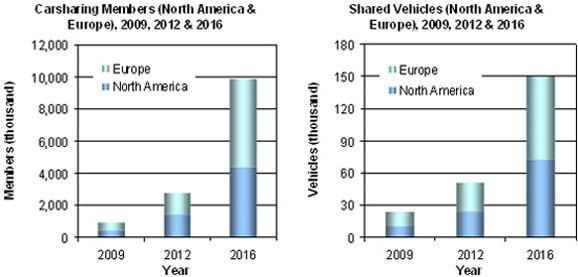A new report from the consulting firm Frost & Sullivan says people are sharing cars more than ever:
The economic recession that started in Dec 2007 in the United States had a huge impact on the global automotive industry. Consumers were forced to be cognizant of fuel efficiency and transit costs. While vehicle manufacturers focus on the development of fuel efficient vehicles, such as hybrids and EVs, alternative mobility services are receiving attention.
Among these services is carsharing, a sustainable and innovative personal mobility solution that is a rising star. The carsharing industry grew significantly in the past two years, showed great potential, and implied huge business opportunities for the stakeholders.
Carsharing is a mode of transport where vehicles are owned by a separate firm or an organization, and shared amongst a number of people throughout the day. Carsharing can also be considered an organized short-term car rental where users access a firm's vehicles maintained in a close network of vehicle locations called "Pods". Starting in Europe, carsharing came to North America in 1994 as an alternative solution to meet the mobility gaps between public transit, taxi, bike, car rental, and private vehicle travel. Carsharing provides its members with the benefits of private cars without the costs and responsibilities of ownership.
The two major social benefits of carsharing are fewer vehicles on the road and lower emissions. Research from Frost & Sullivan estimates that, on average, each shared vehicle replaced 15 personally owned vehicles in 2009 and carsharing members drove 31% less than when they owned a personal vehicle. These two factors translate into 482,170 fewer tons of CO2 emissions and less travel congestion in urban areas.
Consumers benefit from carsharing by being relieved of ownership costs. Frost & Sullivan research shows that an average car owner who drives 12,000 miles a year at an average driving speed of 30 miles per hour can save US$ 1,834 by shifting to a carsharing service. Commuters who drive less than 12,000 miles can save more.
Those benefits, plus the influence of the economic recession and the increasingly stringent global greenhouse gas emissions regulations, fostered the growth of carsharing in both North America and Europe. Between 2007 and 2009, carsharing membership rose by 117% in North America.
The trend is expected to continue over the next 5 to 10 years. According to Frost & Sullivan research, carsharing membership is expected to reach 4.4 million in North America and 5.5 million in Europe by 2016. Chart 1 [at top] shows the growth trends of carsharing membership and total shared vehicles.
The second half of the summary, which explores the business opportunity presented by carsharing, is also worth reading. Is carsharing a new idea for you, and you'd like to learn more? Check out Jill Suttie's "How to Share a Car."
Thanks for the tip, Good magazine!









